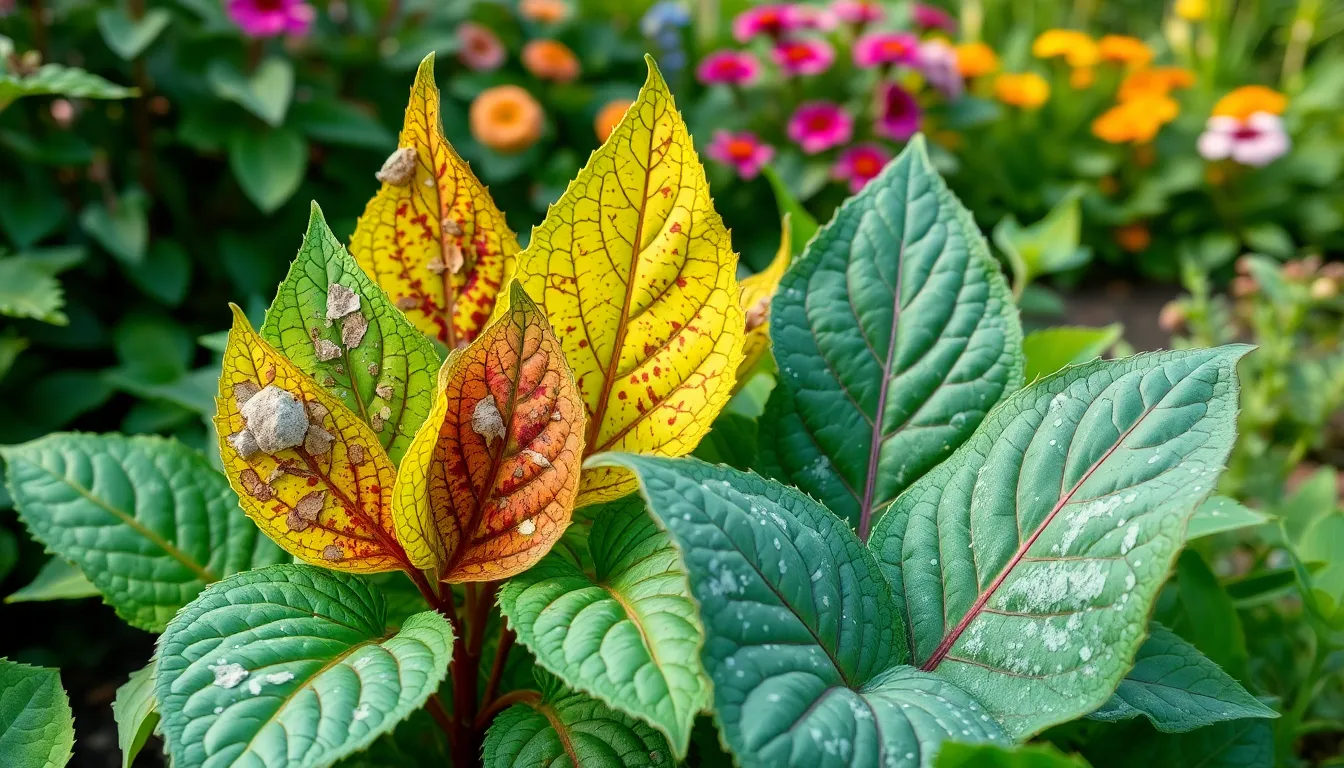Plants are like the pets of the garden world—adorable, loyal, and sometimes a little sickly. Just like your furry friend can catch a cold, plants can fall victim to a variety of diseases that threaten their health and your gardening dreams. From powdery mildew to root rot, these common plant ailments can turn a vibrant garden into a sad patch of wilted leaves faster than you can say “green thumb.”
Common Plant Diseases
Common plant diseases manifest in various forms, each posing unique challenges. Recognizing symptoms is vital for maintaining healthy plants. Powdery mildew appears as a white, powdery substance on leaves and thrives in humid conditions. Root rot results from overwatering, leading to dark, mushy roots and wilting.
Fungal infections often spread rapidly and can lead to plant decline. Clubroot affects cruciferous vegetables, causing swollen roots and stunted growth. Bacterial wilt, seen in cucumbers and tomatoes, leads to sudden wilting and is transmitted by pests.
Insects contribute to disease spread, with aphids and spider mites weakening plants. These pests create stress, making plants more susceptible to infections. Black spot, commonly found on roses, causes dark spots on leaves and can defoliate plants if untreated.
Viruses, too, are prevalent among plant diseases. Mosaic virus presents as mottled leaves and stunted growth. Some viral infections are transmitted by insects, complicating management efforts.
Plant stress from environmental factors plays a significant role in disease susceptibility. Excessive heat or cold can weaken defenses against pathogens.
Effective management relies on recognizing symptoms early. Implementing sanitation practices reduces the risk of disease spread in gardens. Choosing resistant plant varieties also helps in combating common ailments. Regularly inspecting plants and maintaining proper watering practices are crucial for a thriving garden.
Types Of Common Plant Diseases

Various plant diseases can threaten garden health. Understanding these diseases helps in timely intervention.
Fungal Diseases
Fungal diseases appear frequently in gardens. Powdery mildew remains one of the most evident, showing a white coating on leaves. Other infections, like root rot, occur when soil remains overly damp, leading to decayed roots. Fungal pathogens thrive in moist, warm environments. Clubroot affects brassicas, causing swollen roots and stunted growth. These conditions can decimate entire crops if left unchecked. Regular monitoring and proper sanitation decrease the likelihood of fungal outbreaks.
Bacterial Diseases
Bacterial diseases pose significant risks to plants. Bacterial wilt, for instance, affects tomatoes and cucumbers, causing wilting and leaf drop. Symptoms often manifest suddenly, making early detection critical. Another notable disease, fire blight, strikes apples and pears, resulting in blackened shoots. Bacteria spread through contaminated tools, splashing water, and insect activity. Effective management includes rotating crops and maintaining proper garden hygiene. Removing infected plants prevents further contamination and protects healthy specimens.
Viral Diseases
Viral diseases represent another challenge for gardeners. Mosaic virus spreads easily through insect vectors like aphids. Symptoms include mottled leaves and stunted growth, often leading to reduced yields. Other viral threats, such as tobacco mosaic virus, affect a wide range of plants, particularly in warmer temperatures. Infected plants appear weak and may succumb to secondary infections. Controlling these diseases requires careful monitoring of plant health and insect populations. Using resistant varieties proves effective in minimizing viral impact.
Symptoms Of Common Plant Diseases
Recognizing the symptoms of common plant diseases aids in addressing issues promptly. Awareness of these signs contributes to maintaining a healthy garden.
Identifying Signs
Symptoms often vary by disease. Wilting leaves and stunted growth suggest root rot or other root issues. A powdery, white film on leaves usually indicates powdery mildew, particularly under humid conditions. Yellowing or browning leaves can signal nutrient deficiencies or pests, while sudden wilting may imply a bacterial infection. Each symptom holds significance, aiding diagnosis and effective management.
Common Indicators
Common indicators present themselves through more than just visual symptoms. Discoloration on leaves often indicates diseases like leaf spot or blight. Spots with distinct borders might reveal fungal infections, while irregular patterns could point to viral diseases. Stunted or distorted new growth frequently suggests pest interference or systemic disease. Observing these indicators encourages proactive measures to safeguard the garden’s health.
Prevention And Management Strategies
Preventing and managing plant diseases involves employing strategic measures to maintain plant health and minimize risk. Recognizing early symptoms plays a crucial role in addressing issues effectively.
Cultural Practices
Cultural practices significantly reduce the incidence of plant diseases. Rotating crops ensures that pathogens specific to certain plants do not build up in the soil. Implementing proper spacing between plants enhances airflow and reduces humidity, decreasing the likelihood of fungal infections. Watering at the base of plants prevents leaf wetness, limiting the spread of diseases like powdery mildew. Additionally, choosing disease-resistant plant varieties provides an extra layer of protection. Regularly inspecting plants fosters early detection of issues and allows for swift action when problems arise.
Chemical Control Options
Chemical control options serve as additional tools for managing plant diseases. Fungicides effectively target fungal pathogens when applied according to label instructions. Bactericides can protect against bacterial diseases, preventing further spread within the garden. Insecticides, when necessary, help manage pests that contribute to disease transmission. Integrated Pest Management combines chemical controls with cultural practices for a more sustainable approach. Always consider the potential impact on beneficial organisms and the environment when selecting chemical treatments. Some chemicals require specific conditions for efficacy, making careful application essential.
Conclusion
Maintaining a healthy garden requires vigilance and knowledge about common plant diseases. By understanding the symptoms and challenges associated with these ailments, gardeners can take proactive steps to protect their plants. Early detection is key to preventing the spread of diseases like powdery mildew and root rot.
Employing effective management strategies such as crop rotation and using disease-resistant varieties can greatly enhance a garden’s resilience. Regular inspections and proper sanitation practices further contribute to a thriving environment. With the right approach, gardeners can enjoy the beauty and benefits of their plants while minimizing the impact of diseases.




